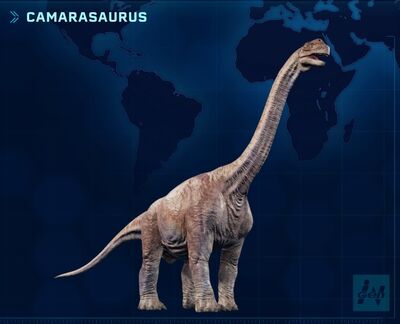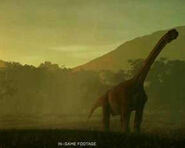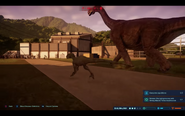
Camarasaurus is an unlockable dinosaur in Jurassic World Evolution.
Information
Camarasaurus fossils are unlocked once the player ___.
Base Stats (at 100% Genome) | |
|---|---|
| Attack | 38 |
| Defense | 0 |
| Lifespan | 121 |
| Resilience | 53 |
| Rating | 128 |
| Incubation Cost | $678,000 |
Dig Sites
- Cleveland Lloyd Dinosaur Quarry
- Dinosaur National Monument
- Morrison Formation
Skins
- Savannah Pattern
- Woodland Patern
- Rainforest Pattern
- Jungle Pattern
- Steppe Pattern
Genome
Camarasaurus has 12 Gap ID slots to modify.
- Cosmetic
- Lifespan
- Habitat
- Resilience
- Resilience
- Habitat
- Lifespan
- Lifespan
- Stress
- Resilience
- Social
- Lifespan
Bio
Profile
- Camarasaurus can eat massive amounts from tall herbivore feeders.
- They live in one of the smallest social groups for sauropods, but can also live alongside large numbers of other species.
- These dinosaurs require a large amount of land area to thrive, with the bulk of it being forest.
Classification | |
|---|---|
| Giant Herbivore | |
Health Requiremen | |
| Appetite | 234 |
| Metabolism | 3.09 |
Comfort Requirement | |
| Comfort Threshold | 45% |
| Grassland | 14,700 m2 |
| Forest | 24,800 m2 |
| Wetland | 0 m2 |
| Ideal Population | 0 - 23 |
| Social Group | 2 - 7 |
Disease | |
| Susceptible | Braken Poisoning |
| Immune | Common Cold |
Food Preference | |
| Primary Preference | Conifers |
| Secondary Preference | Ginkgo |
| Tree Ferns | |
| Harmed By: | Paw Paw |
| Mosses | |
| Horsetails | |
InGen Database
Stats | |
|---|---|
| Era | Late Jurassic |
| Family | Macronaria |
| Genus | Camarasaurus |
| Height | 6.4 m |
| Weight | 51 T |
| Length | 18.0 m |
| Feeder Type | Tall Herbivore |
Description
- Camarasaurus was a large sauropod that once roamed North America. It likely lived in herds and featured a comparatively shorter neck and tail than most sauropods, but a larger head. Its name means 'chambered lizard'.
- It's one of the most commonly found sauropod fossils. Its chisel-shaped teeth were suitable for consuming coarse plant matter.
Discovery
- The fist Camarasaurus find was in 1877 during the Bone Wars. Most fossil finds so far have been within the Morrison Formation.
- A full skeleton of Camarasaurus was found in 1925, but it was a juvenile specimen that led many to believe the species was smaller than current thinking.
- Complete skeletons have been found in Colorado, New Mexico, Utah, and Wyoming.
Paleoecology
- A wide range of dinosaur species are found in the Morrison Formation. The area had a semi-arid climate.
- In the Morrison Basin there was more water with swampy lowlands, lakes and river channels.
Trivia
- Its tail is depicted as being close to the ground, though in reality it would have been positioned much higher above the ground.










